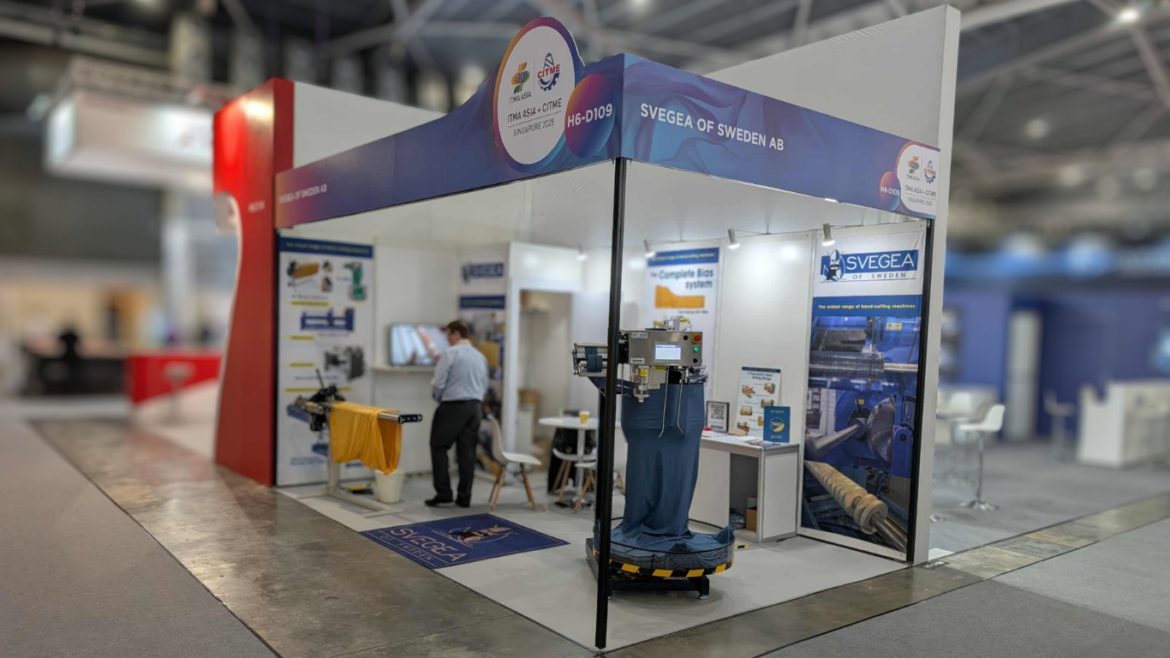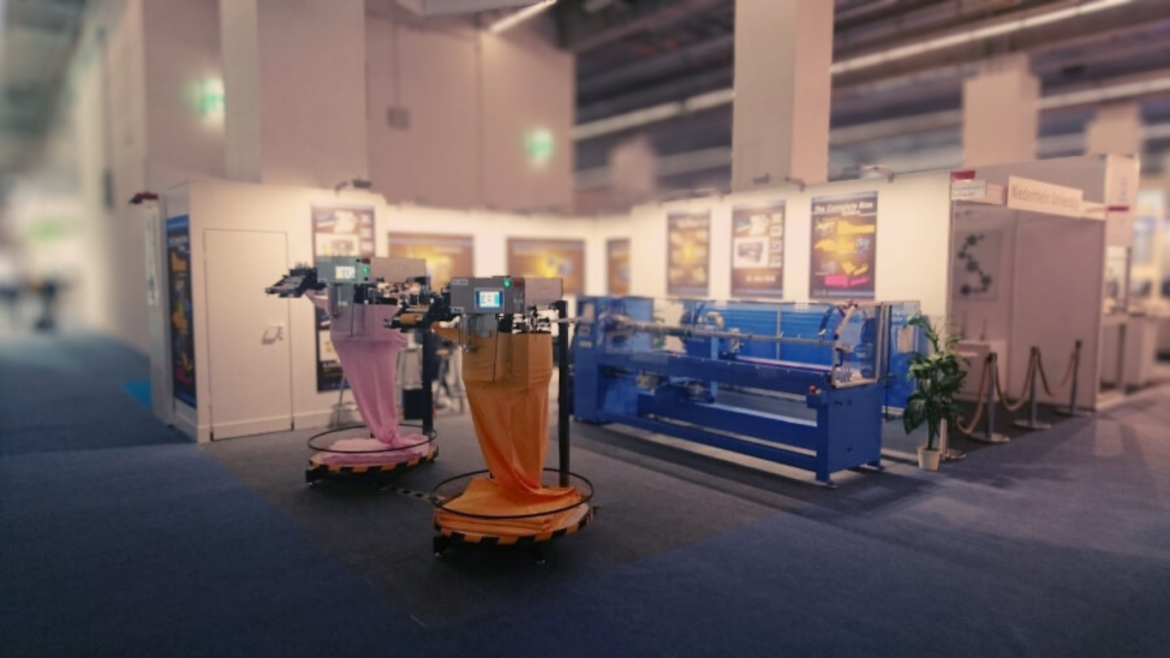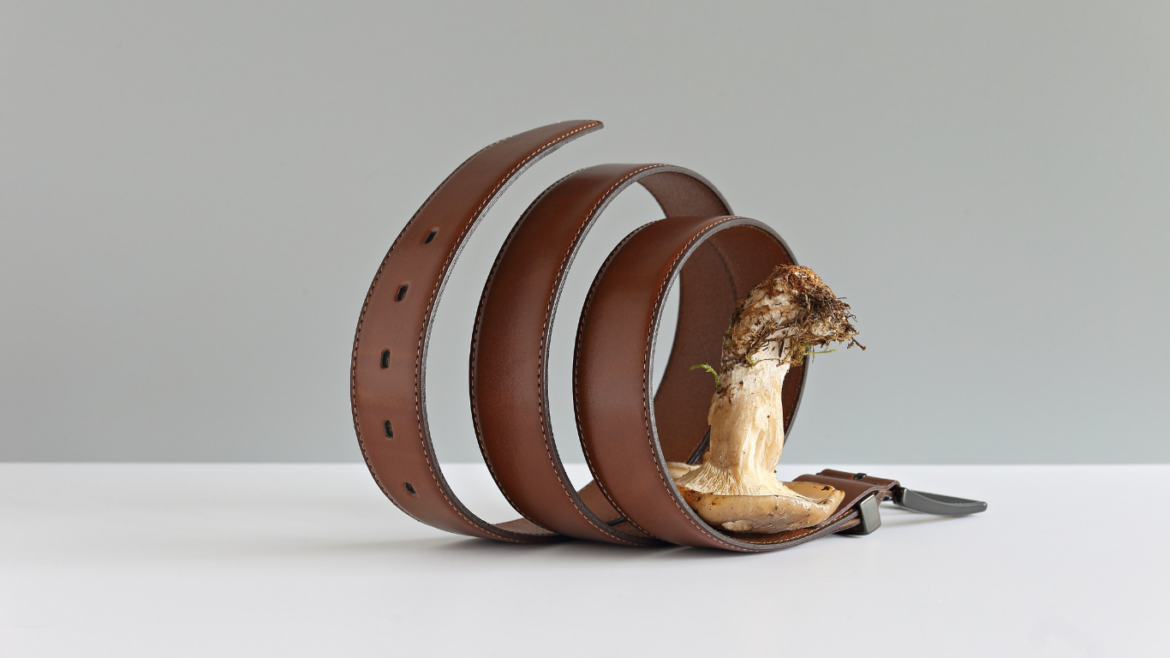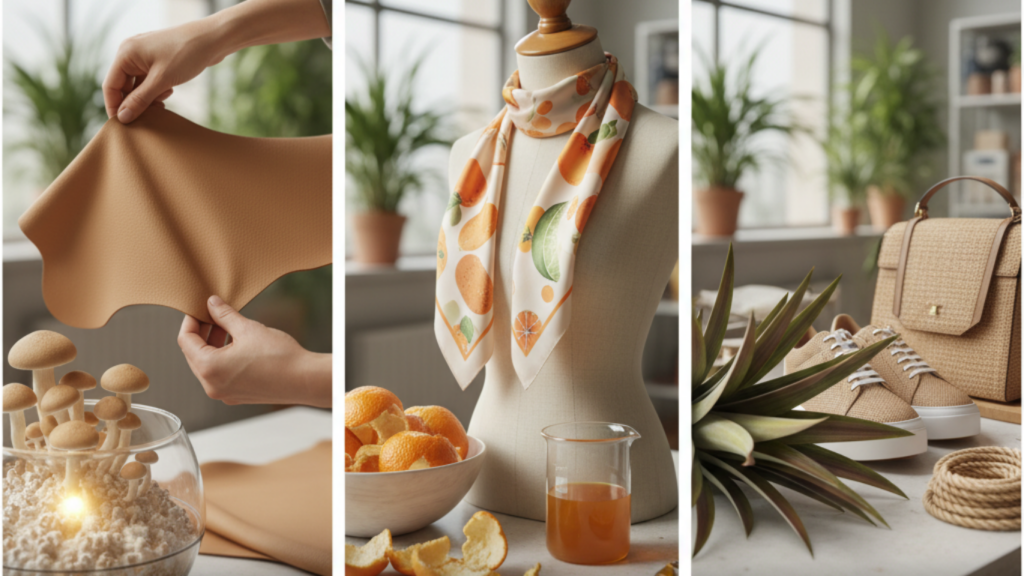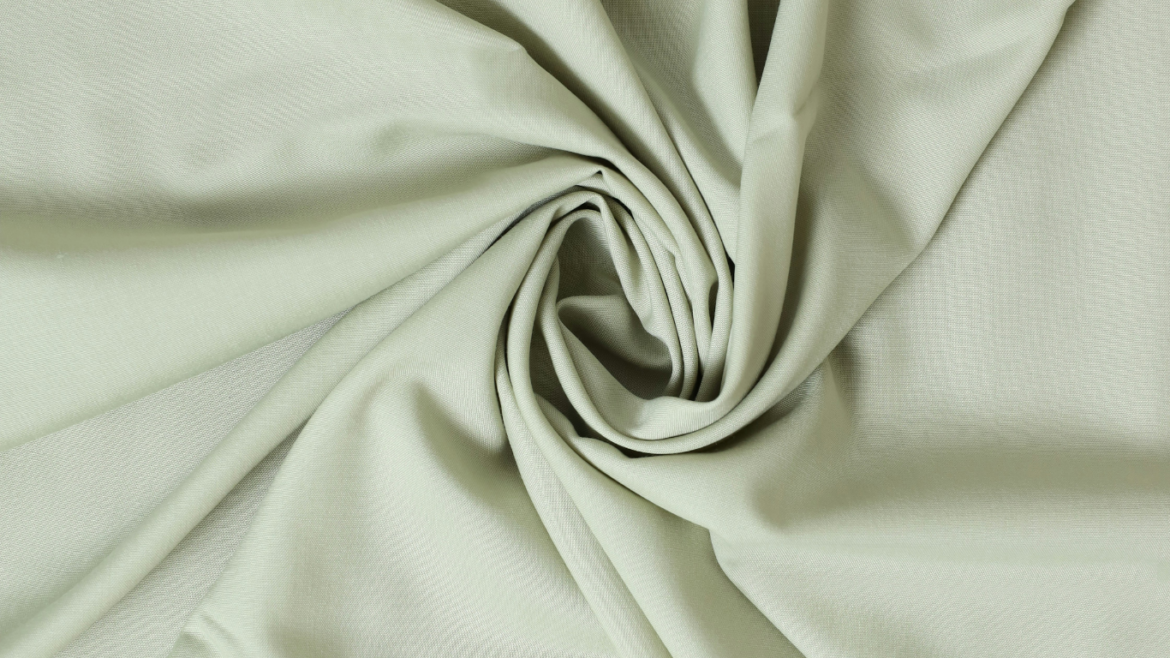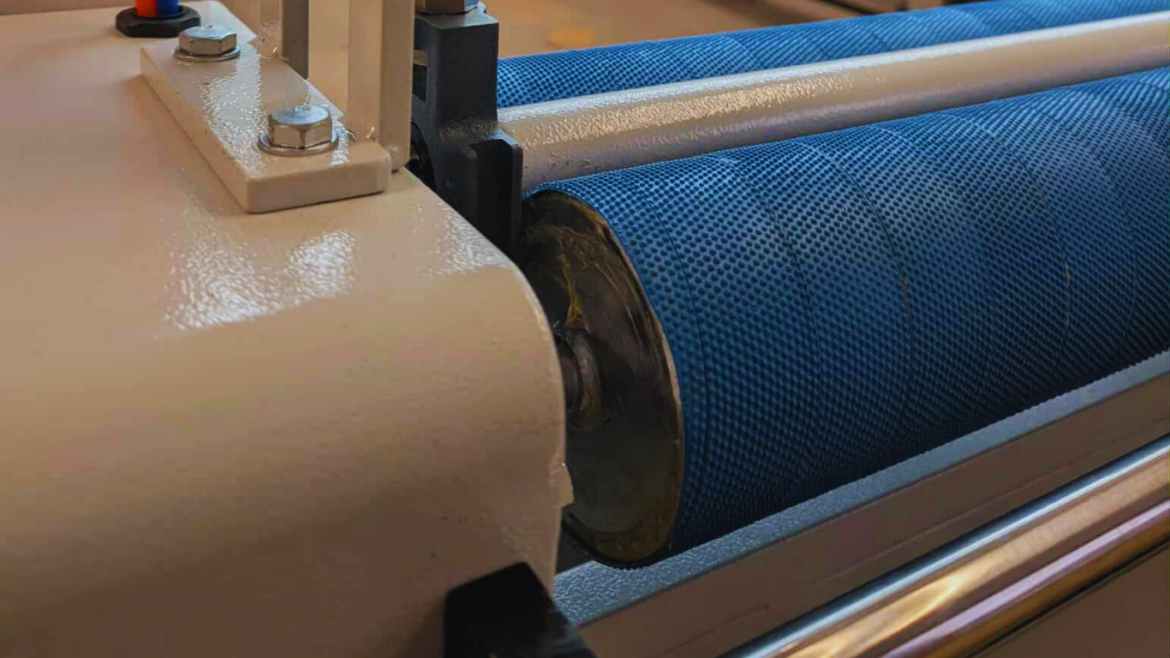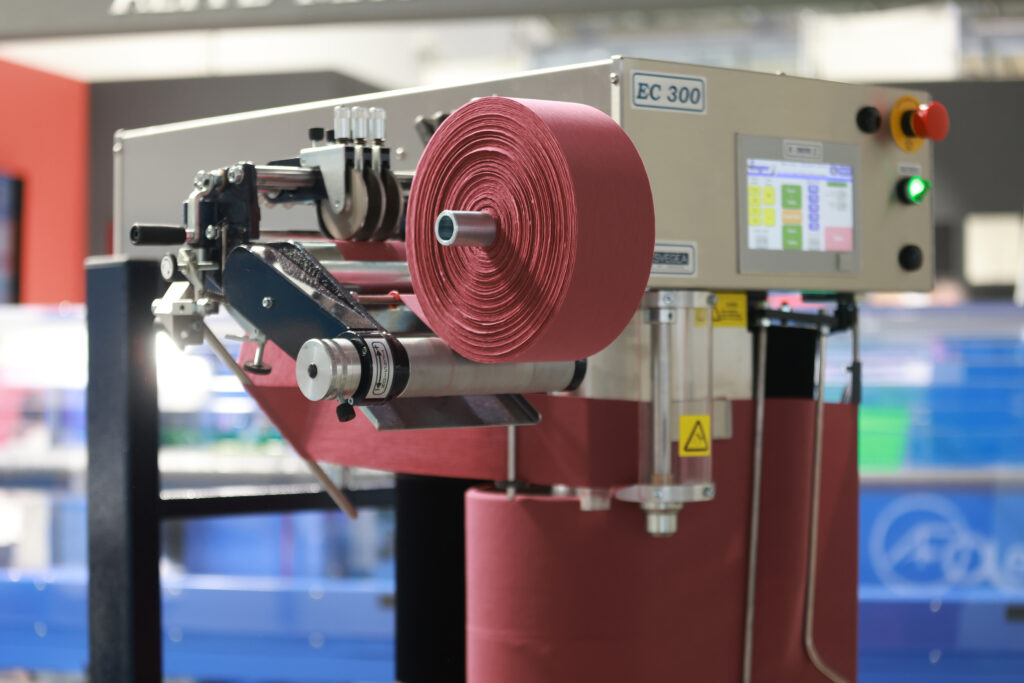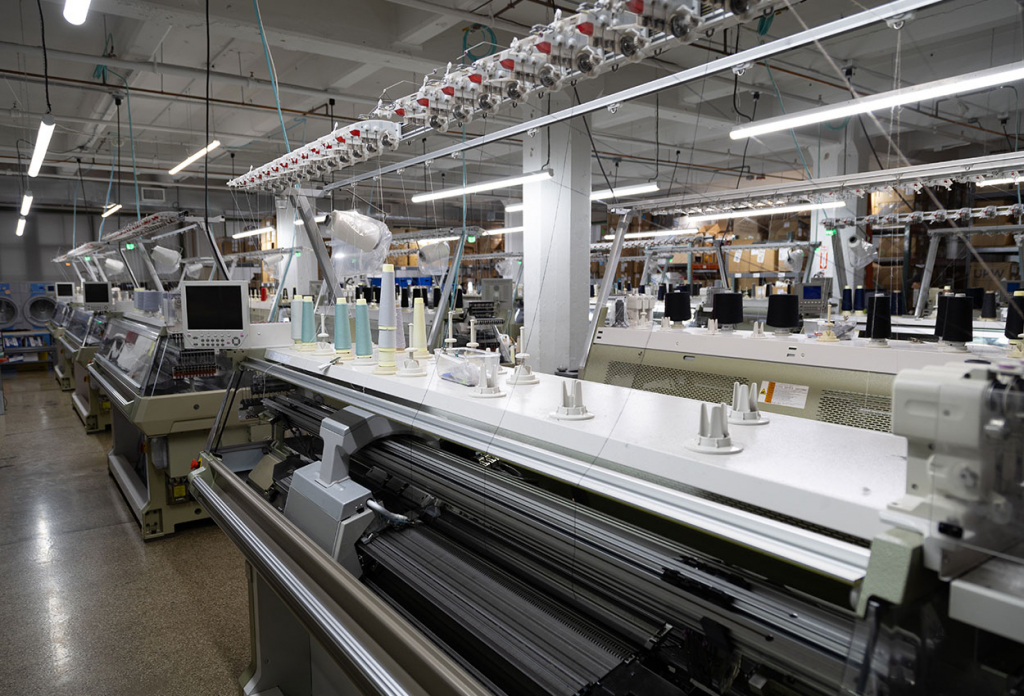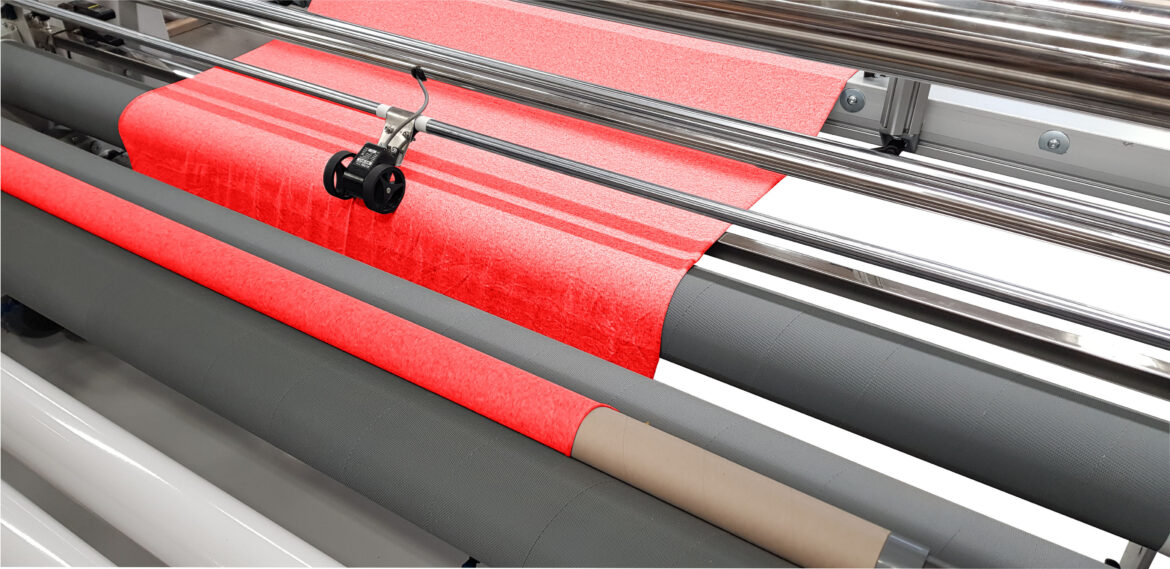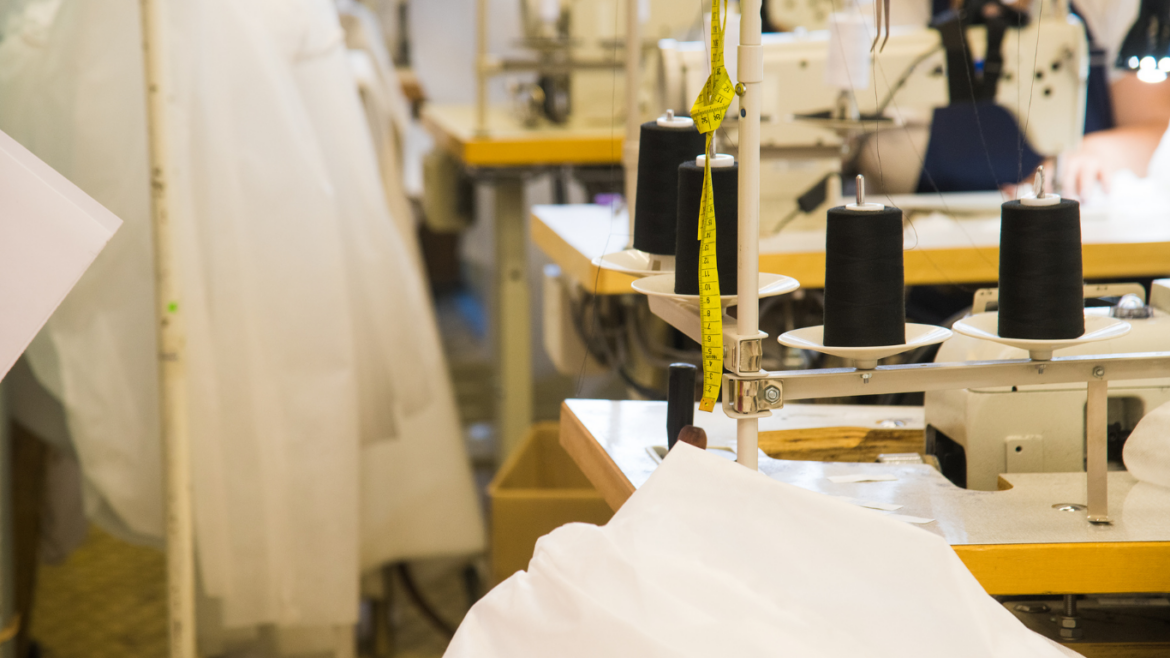The ITMA ASIA + CITME exhibition in Singapore wasn’t just another industry event—it was a heartbeat moment for the textile world. For us at Svegea of Sweden, it was a chance to stand shoulder-to-shoulder with visionaries, innovators, and changemakers who believe that textile manufacturing can—and must—be a force for good
With over 840 exhibitors and thousands of passionate attendees, the energy was electric. The conversations weren’t just about machines; they were about meaning. About how we, as a global community, can drive sustainability, embrace digital transformation, and build a supply chain that respects both people and planet.
At our booth, we weren’t just presenting technology—we were planting seeds for a better future.
Empowering Asia’s Green Transition
Singapore was the perfect stage for a pivotal shift. By bringing Swedish innovation closer to the dynamic markets of South and Southeast Asia, we’re helping manufacturers leap forward—not just in productivity, but in purpose.
We’re not here to sell machines. We’re here to build partnerships. To guide manufacturers through the maze of global regulations, ethical standards, and environmental goals. The conversations I had were rich with urgency and optimism—focused on resource efficiency, circularity, and renewable integration. Svegea’s solutions aren’t just engineered for performance; they’re designed to empower transformation.
Global Connection, Shared Values
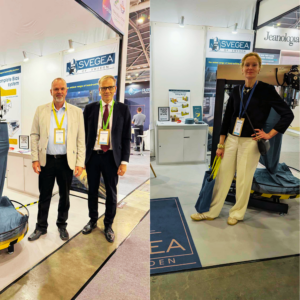 One of the most inspiring moments was welcoming Anders Sjoberg, Swedish Ambassador to Singapore, to our booth. His presence was more than symbolic—it was a powerful endorsement of Sweden’s leadership in ethical innovation and sustainable industry.
One of the most inspiring moments was welcoming Anders Sjoberg, Swedish Ambassador to Singapore, to our booth. His presence was more than symbolic—it was a powerful endorsement of Sweden’s leadership in ethical innovation and sustainable industry.
We were also honored to host Therese Premler-Andersson, General Secretary of TMAS. Her visit reminded us that collaboration is the cornerstone of progress. No single company can solve the textile industry’s challenges alone. But together—through shared knowledge, mutual respect, and bold action—we can reshape the future of fashion and manufacturing.
Beyond the Sale: A Promise to the Future
As we dismantled our booth, what lingered wasn’t the hum of machinery—it was the spirit of possibility. ITMA ASIA + CITME reaffirmed our belief that innovation and ethics must walk hand in hand. The focus wasn’t on quantity—it was on quality, impact, and intention.
These four days have galvanized our mission. We will continue to develop durable, high-performance technologies that enable manufacturers to produce exceptional garments while protecting our planet. The journey doesn’t end here—it begins anew, with deeper partnerships and bolder goals.
Tack för stödet (Thank you for the support). If you’re ready to elevate your sustainable production, I invite you to connect with our team leader, Håkan Steene, for a hands-on demonstration of the EC COLLARETTE 200 and EC 50: h.steene@svegea.se.
Let’s build the future—together.
In today’s fast-paced textile industry, precision, speed, and sustainability are no longer optional — they’re essential. That’s why manufacturers around the world are turning to Swedish textile cutting machinery — specifically Svegea, a company that’s been redefining automated cutting solutions since 1952.
Svegea’s Swedish-engineered solutions help manufacturers by focusing on automation, sustainability, and user-friendly design to improve efficiency, reduce waste, and adapt to market demands. Their machines support the creation of smarter, more connected factories through integration with Industry 4.0 principles, making them ideal partners for reshoring efforts and sustainable production goals.
Automation: The Foundation of Competitive Manufacturing
High-Speed Precision Cutting
Svegea’s textile cutting machinery from Sweden is engineered for high-speed, precise cutting, which helps produce consistent quality and faster production times. Every machine is designed to maintain exacting standards even at maximum operational speeds, ensuring that manufacturers can scale production without sacrificing quality.
- EC-450XF Collarette Cutting System: Awarded at Texprocess 2023 for its innovation and sustainability, this fully automatic system delivers high-speed, low-waste performance with precision that’s become the industry benchmark.
- Euro-Collarette Fully Automatic Series: These models feature the intuitive E Drive 2 panel and two-step cutting for multiple bands — ideal for high-volume operations requiring consistent output.
Automated Processes That Reduce Labor Dependency
Svegea integrates automatic tube sewing units for creating sewn tubes in rolled or flat-folded forms, reducing the need for operator assistance and minimizing human error.
- TSU 200 A/AF Tube Sewing Unit: Minimal operator input, maximum efficiency. This system exemplifies how automation enables manufacturers to redirect skilled labor to higher-value tasks.
- Bias Cutter / Winder 200: Smooth unwinding and rewinding into single ply rolls with minimal manual intervention.
- Bias Cutter CMB 1800: Versatile and adaptable across fabric types, streamlining the entire bias binding process.
Supporting Reshoring with Smart Automation
Automation facilitates reshoring operations by making local manufacturing more competitive and efficient. Sweden’s textile cutting machinery industry leads this transformation, offering manufacturers the tools they need to bring production home without sacrificing cost-effectiveness.
Sustainability: Engineering for a Better Future
Precision That Reduces Waste
Precision cutting and automation help maximize fabric usage, minimizing material waste. Svegea’s machines are engineered to optimize every centimeter of fabric, contributing directly to both profitability and environmental responsibility.
- Strip Cutter CMS 1800A2: High-speed cutting for bias tape, trims, and bindings with advanced nesting algorithms that reduce offcut waste.
- TSO 380 G/GF Tubular Knit Slitter: Reduces waste and improves material yield through intelligent cutting patterns.
Energy-Efficient Engineering
Svegea’s machinery is designed to be energy efficient, lowering consumption and environmental impact. Every system is optimized for minimal power draw without compromising performance, making textile cutting machinery from Sweden a smart choice for manufacturers committed to reducing their carbon footprint.
- RRS-800 Fully Automatic Roll Slitting Machine: Offers motorized knife control and adjustable speed for consistent quality while maintaining low energy consumption throughout extended production runs.
Supporting Circular Economy and Recycled Materials
By improving garment durability and promoting longevity through efficient production, Svegea’s machines contribute to a more circular economy. The advanced technology can support the use of recycled materials in production, accommodating the varied characteristics of reclaimed fabrics without compromising cut quality.
- FIM CMI 210 R / ZR Fabric Inspection Machine: Detects defects and inconsistencies in both virgin and recycled materials before they reach the cutting floor, ensuring quality regardless of source.
User-Friendly Design: Versatility Meets Accessibility
Adaptable Across Material Types
The cutting machines can handle a wide range of materials, from delicate silks to heavy-duty industrial textiles. This versatility makes Swedish textile cutting machinery ideal for manufacturers serving diverse market segments.
- SV/BK Band Knife Series: Precision cutting for everything from delicate silks to heavy-duty fabrics, with easily adjustable settings for quick material transitions.
- Strip Cutter FA 500: Heavy-duty and reliable, perfect for long production cycles with materials ranging from PVC to non-woven fabrics.
Quick Changeovers for Maximum Productivity
User-friendly interfaces and the ability to quickly switch between patterns and materials reduce downtime and enhance productivity. The intuitive E Drive 2 control panel makes complex operations accessible to operators at all skill levels.
- Euro-Collarette Semi-Automatic Series: A semi-automatic option that cuts two bands simultaneously, with widths ranging from 16 to 140 mm — changeable in minutes, not hours.
Customization for Niche Applications
Svegea provides custom-specific machines and units for niche applications like bias cutting, and can adapt to diverse customer preferences. This flexibility ensures that whether you’re producing standard collarettes or specialized technical textiles, there’s a solution engineered specifically for your needs.
- W 2100S Fabric Rewinding Machine: Perfect re-rolls every time, with customizable tension and speed settings for different fabric types.
Industry 4.0 Integration: Building Smarter Factories
Sweden’s textile cutting machinery leads the way in smart manufacturing integration. Designed to connect seamlessly with modern factory management software the Svegea system enables:
- Real-time production monitoring and quality control
- Predictive maintenance scheduling to minimize downtime
- Data-driven optimization of cutting patterns and material usage
- Integration with inventory and supply chain management systems
This connectivity transforms individual machines into components of an intelligent manufacturing ecosystem. The result? Long-term competitiveness in an increasingly digital industry.
The Swedish Advantage: Seven Decades of Innovation
Textile cutting machinery from Sweden represents more than a geographic label — it’s a commitment to quality, innovation, and sustainability. Svegea embodies the best of Swedish engineering: meticulous attention to detail, long-term reliability, and environmental responsibility.
Svegea has been serving global textile manufacturers since 1952, continuously innovating to meet the evolving demands of modern production. This heritage of excellence makes Swedish textile cutting machinery a global benchmark for quality, sustainability, and technological advancement.
Ready to Transform Your Production Line?
Experience how premium Swedish textile cutting machinery can revolutionize your operations. Whether you’re looking to reshore production, reduce waste, improve efficiency, or build an Industry 4.0-ready factory, Svegea has the solutions you need.
Explore Svegea’s full range of automated textile solutions at svegea.se. For a personalized product demo and consultation, contact Håkan Steene at h.steene@svegea.se.
Let’s build the future of sustainable, efficient textile manufacturing — together.
Fashion is changing—and fast. Today, being eco-friendly isn’t just a trend. It’s a smart move. People care more about the planet, and they want clothes made responsibly. That’s where fabric innovation comes in. It’s helping fashion brands create better materials and use smarter machines to make clothes in cleaner ways.
Let’s explore how new fabrics and modern machines are working together to build a more sustainable fashion industry.
New Materials, New Possibilities
For years, most clothes were made from cotton or polyester. These materials use a lot of water, chemicals, and energy. But now, designers are using things like fruit peels, mushrooms, and even carbon from the air to make fabric.
Here are a few examples:
- Mylo: A soft, leather-like material made from mushroom roots. It feels like real leather but is biodegradable and doesn’t harm animals.
- Orange Fiber: Made from leftover citrus peels. It’s silky and smooth, perfect for dresses and scarves.
- Piñatex: Created from pineapple leaves. It’s strong and flexible, often used in shoes and bags.
These new fabrics are stylish, durable, and better for the environment. They break down naturally and don’t need as many resources to produce. People want to know where their clothes come from, and brands are responding with cleaner, smarter choices.
Machines That Make It Happen
These cool new fabrics wouldn’t exist without the right machines. Today’s textile machines are smarter and greener than ever. They use less water, less energy, and fewer chemicals.
Let’s break down what these machines do:
- Dyeing machines with closed-loop systems: These machines clean and reuse water during the dyeing process. That means less pollution and lower water bills.
- Spinning machines with smart sensors: These sensors adjust the yarn tension automatically. This helps reduce waste and keeps the fabric smooth and strong.
- Aluminum extrusion frames: These lightweight frames make machines faster and easier to maintain. They also use less energy during production.
This is where fabric innovation meets smart engineering. By using better materials and better machines, factories can make high-quality clothes while protecting the planet.
Why Going Green Is Good for Business
Being sustainable isn’t just good for the Earth—it’s good for business too. Brands that use fabric innovation often save money and attract more customers.
Here’s how:
- Lower energy costs: Machines that use less electricity help reduce monthly bills.
- Fewer labor expenses: Automated systems do more work with fewer people, saving time and money.
- Longer-lasting products: Strong, recyclable fabrics mean fewer returns and happier customers.
Also, governments are starting to set stricter rules about waste and pollution. Companies that switch to cleaner methods now will be ready for the future—and avoid fines or delays.
Recycling Clothes: The Circular Fashion Idea
One of the coolest parts of fabric innovation is how it helps with recycling. Instead of throwing old clothes away, companies can now turn them into new fabric.
Here are some exciting developments:
- Fiber-to-fiber recycling: This process breaks down old clothes and spins them into fresh yarn. It keeps materials in use and out of landfills.
- Carbon capture polyester: Some companies are turning carbon dioxide from factory smoke into polyester fabric. It’s a smart way to clean the air and make clothes.
- Lab-grown cotton: Scientists are growing cotton in labs without using farmland or pesticides. It’s clean, safe, and doesn’t harm the soil.
These ideas are already being tested in places like Europe and Asia. They help reduce trash, save resources, and even create new jobs.
Working Together to Make It Work
To make all this happen, people across the fashion world need to team up. Garment manufacturers, fabric developers, and clothing brands must share ideas and work together.
Here’s what that looks like:
- Engineers designing new machines: These machines can handle unusual fabrics like mushroom leather or pineapple fiber.
- Designers experimenting with new styles: They’re testing how these new materials feel, look, and move.
- Factory owners rethinking production: They’re changing how they plan, cut, and ship products to reduce waste and save money.
This teamwork is what makes fabric innovation so powerful. It’s not just about one product—it’s about changing the whole system.
Fashion Innovation is Growing Every Day
If you’re a garment maker, designer, or business owner, this is your moment. The tools are ready. The materials are here. And the demand for sustainable fashion is growing every day.
“At Svegea, we believe fabric innovation is the heartbeat of modern fashion. That’s why we’re constantly evolving our machinery—making it smarter, cleaner, and more adaptable—so garment and textile manufacturers can stay ahead in a fast-changing industry.” — Hakan Steene, Managing Director of Svegea of Sweden
Reach out to Hakan Steene at h.steene@svegea.se to explore how Svegea’s textile machinery can help you lead the way. Whether you’re upgrading your factory or starting fresh, Svegea offers smart solutions that fit your goals—and your budget.
Fabric shrinkage is one of the most overlooked challenges in garment manufacturing. It can lead to misaligned patterns, wasted material, and inconsistent sizing. If you want to prevent fabric shrinkage before cutting, you need to understand what causes it and how to control it.
Let’s explore practical ways to reduce shrinkage and improve cutting accuracy — without adding complexity to your workflow.
Why Does Fabric Shrink?
Shrinkage happens when fibers contract due to heat, moisture, or mechanical stress. Natural fabrics like cotton, rayon, and linen are especially prone to this. Even synthetic blends can shrink slightly under certain conditions.
When fabric is cut before it stabilizes, the final garment may twist, pucker, or lose its intended shape. That’s why it’s essential to prevent fabric shrinkage before cutting — not after.
Pre-Shrinking vs. Relaxing: What’s the Difference?
Pre-shrinking involves washing or steaming the fabric before cutting. While this method works, it’s often inconsistent and time-consuming. Relaxing, on the other hand, allows the fabric to settle naturally. It reduces internal tension caused by rolling, folding, or transport.
For knitwear and stretch fabrics, relaxing is especially effective. It helps prevent fabric shrinkage before cutting by allowing fibers to return to their natural state.
5 Proven Ways to Prevent Fabric Shrinkage Before Cutting
1. Use a Fabric Relaxing Machine
A fabric relaxing machine gently unwinds and settles the fabric. It reduces tension and helps stabilize the material. This is one of the most reliable ways to prevent fabric shrinkage before cutting in high-volume production.
2. Control Room Conditions
Humidity and temperature affect fiber behavior. Keep your cutting room at a consistent humidity level (around 60–70%) and avoid sudden temperature changes.
3. Let Fabric Rest
If you don’t have a relaxing machine, lay the fabric flat and let it rest for 12–24 hours. This passive method still helps reduce shrinkage and curling.
4. Test Shrinkage Rates
Before bulk cutting, test a small swatch. Wash or steam it, then measure the change. This helps you adjust your cutting patterns and prevent shrinkage before cutting large batches.
5. Avoid Immediate Cutting
Fabric fresh off the roll is often under tension. Give it time to settle before cutting to avoid distortion and waste.
Why It Matters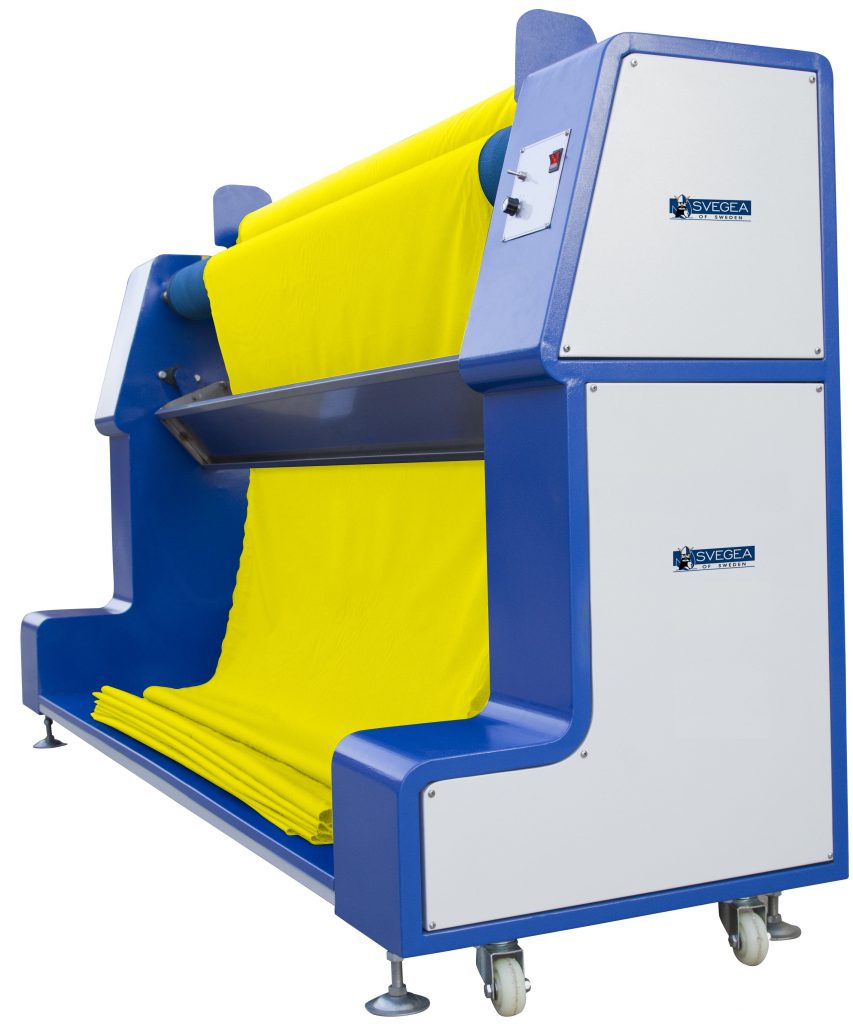
Controlling fabric shrinkage before cutting is essential for consistent garment quality. Shrinkage can distort patterns, misalign seams, and lead to costly rework. By stabilizing fabric early—through relaxing, resting, or testing—you reduce waste and improve production accuracy. This not only protects your materials but also strengthens your brand’s reliability. Manufacturers who take shrinkage seriously deliver better-fitting garments and fewer returns. In a competitive market, precision matters. Starting with properly prepared fabric sets the tone for everything that follows.
Integrating Fabric Relaxing System
Want to improve cutting accuracy and reduce waste? Start by integrating fabric relaxing into your workflow. Whether through manual rest periods or automated systems, the results will speak for themselves.
Many manufacturers now rely on purpose-built equipment like fabric relaxing machines to stabilize material before cutting. These systems gently release tension in the fabric, helping reduce shrinkage and distortion. One example is the CR-210 Fabric Relaxing Machine, which is designed to support high-volume production environments where consistency is key.
By making fabric relaxation a standard part of your process, you set the stage for cleaner cuts, better fit, and fewer production errors.
For a product demo or expert guidance, email Håkan Steene at h.steene@svegea.se
Factories face three hard truths: fabric costs keep rising, buyers want faster delivery, and sustainability matters to customers and regulators. Improving garment manufacturing efficiency puts these pressures into practical order. Get this right and you cut costs, gain speed, and reduce waste.
Where waste really bites
Small mistakes cost big. A mis-inspected roll can mean meters of unusable fabric. Manual checks slow lines and create rework. Labor shortages and rising wages exacerbate every inefficiency. That is why garment manufacturing efficiency must be a daily focus, not a quarterly idea.
Trends pushing factories to change
Across the industry, manufacturers are adopting digital tools. Marker optimization reduces raw material use. Real-time dashboards track defects. Automation speeds repetitive tasks while freeing people to solve problems. Together, these moves enhance garment manufacturing efficiency and make factories more scalable.
Tools that move the needle
Automation is not a single gadget. It is a set of targeted investments that deliver repeatable gains. Start with quality control. Automated inspection and reliable cutting reduce rework and scraps. Next, connect systems so design files, markers, and production data flow without manual transfers. That reduces setup time and avoids costly mistakes. Focused improvements add up fast when your goal is garment manufacturing efficiency.
Fabric inspection: the unsung hero
A lot of manufacturers undervalue inspection. A good inspection line catches faults before cutting, preventing defects that would otherwise propagate through sewing and finishing. The CMI 210 ZR fabric inspection machine is built for that exact role. It handles rolls up to 2100 mm, runs roll-to-roll or roll-to-flat, and offers variable electronically controlled speed, photocell edge alignment, and electronic tension adjustments. That level of control reduces hidden waste at the source.
Collarette cutting: precision where it matters
Certain parts of a garment reveal flaws instantly. Collarette and binding components need uniform width and clean edges. Svegea’s collarette cutting machines cover semi-automatic and fully automatic models. They handle tubular knitted fabric with adjustable widths from about 16 to 140 mm. The standard setup cuts two bands at once, and knife units can be added for more. For high-volume runs, the automatic systems remove variability and keep quality consistent.
What success looks like in real numbers
When factories prioritize process control and the right equipment, they see measurable results. Expect fabric waste to drop, lead times to shorten, and quality rejects to decline. These improvements drive margin expansion and help with sustainability reporting. In short, garment manufacturing efficiency converts directly into competitive advantage.
A simple plan to get started
Start methodically. First, audit the cutting and inspection rooms to find where most scrap and rework come from. Next, pilot one change. Try a fabric inspection line or a semi-automatic collarette cutter on a single product style or order run. Train the operators, collect data, and tweak. Finally, scale what proves out. This stepwise approach helps you manage cost and avoid disruption.
The business case
The math usually lands in your favor. Less waste means lower material spend. Tighter quality control means fewer returns and less rework. Faster setup times mean you can run smaller batches and respond to demand. That combination raises throughput without endless headcount increases. If you want to improve garment manufacturing efficiency, this is the route most executives choose.
Focusing on the right tools
Efficiency is not glamorous, but it is decisive. Focus on the right mix of inspection, precise cutting, and connected workflows, and you will see both cost and time benefits. Machines that support those goals, whether a robust inspection unit like the CMI 210 ZR or a scalable Euro-Collarette cutter, are tools that turn good intentions into measurable results.
For a demo or to discuss how this fits your production, contact Håkan Steene at h.steene@svegea.se or visit the Svegea product pages.
The fashion and textile industry is changing fast. More brands are shifting to on-demand textile production to reduce waste and meet customer expectations. Instead of making large batches that may never sell, manufacturers now focus on producing only what’s needed. This approach helps cut costs, save materials, and support sustainability goals.
Sustainability isn’t just a trend—it’s a must. From fabric waste to energy use, every part of the production process matters. And one of the smartest ways to make a difference is through precision.
Why Waste Reduction Matters
Fabric waste is a hidden problem in many factories. Every scrap, wrong cut, or rejected item means:
- Lost money: Fabric is expensive, and waste eats into profits
- Environmental harm: Most textile waste ends up in landfills
- Extra work: Fixing mistakes takes time and energy
When these issues happen often, they add up fast. That’s why reducing waste is good for both the planet and the bottom line.
The Circular Economy in Textiles
The circular economy is all about keeping materials in use and cutting down on waste. In fashion, this means:
- Designing products that last
- Recycling fabrics and fibers
- Using every roll of material wisely
On-demand textile production fits right into this model. By making only what’s needed, factories avoid overproduction and reduce leftover stock. But even before recycling starts, precision machinery helps cut waste at the source.
Precision Technology: Small Changes, Big Impact
Big changes don’t always need big investments. Machines that cut fabric with accuracy, run efficiently, and reduce errors can make a huge difference.
Here’s how precision machinery helps:
- Less fabric waste: Every cut is clean and exact
- Fewer mistakes: Consistent quality means fewer rejects
- Lower energy use: Efficient machines run faster and smarter
- Longer machine life: Durable tools need fewer replacements
These small upgrades support on-demand textile production by making each step more efficient and less wasteful.
Real-World Impact: Knitwear and Trims
Think about a factory making trims for t-shirts. If they use old cutting methods, they might waste 5–10% of their fabric. But with modern precision cutters:
- Every strip is cut perfectly
- Waste drops by several meters per run
- Quality stays high, so there’s less rework
This kind of setup supports on-demand textile production by allowing quick changes and small batch runs without losing efficiency.
Sustainability as a Competitive Edge
Today’s shoppers care about the planet. Brands that show they’re eco-friendly often win more trust and more business. For manufacturers, this means:
- Getting contracts with green-focused brands
- Meeting global rules on waste and emissions
- Standing out in a busy market
Using precision machinery and switching to on-demand textile production helps factories prove they’re serious about sustainability.
Make the Smart Choice Now
Sustainability starts with smart choices. By using precision tools and embracing on-demand textile production, manufacturers can cut waste, save money, and meet modern demands.
Ready to make your production line more efficient and eco-friendly?
📩 Contact Håkan Steene for a product demo at h.steene@svegea.se or visit https://www.svegea.se to learn more.
Image courtesy of Services – Fashinnovation
The fashion industry thrives on change—but in recent years, that change has accelerated into a full-blown revolution. No longer are brands defined by two seasonal collections and predictable production cycles. Today’s consumers demand personalization, limited editions, and lightning-fast turnaround. They expect garments that feel tailor-made, not mass-produced—and they want them now.
For garment and textile manufacturers, this shift isn’t just a trend—it’s a wake-up call. Meeting these demands requires more than creativity; it calls for operational reinvention. From design to delivery, every stage must be faster, smarter, and more adaptable. That’s where automated textile production enters the picture, enabling manufacturers to respond with precision, speed, and scalability.
At the heart of this transformation lies one powerful principle: flexibility.
The Rise of On-Demand Production
If one trend is reshaping the textile landscape, it’s on-demand production. Instead of stockpiling inventory and gambling on what might sell, brands now produce in smaller, agile batches—sometimes even one item at a time.
Why is this happening?
- Personalization sells. Whether it’s a custom sports jersey or a limited-edition streetwear drop, consumers crave uniqueness.
- Sustainability matters. Overproduction is one of fashion’s biggest environmental pitfalls. On-demand production helps reduce waste by making only what’s needed.
- Agility wins. Smaller runs allow brands to test the market, pivot quickly, and scale up with confidence.
In short, mass customization is overtaking mass production. And manufacturers who fail to adapt risk being left behind.
Flexibility on the Factory Floor
On-demand production sounds ideal—but it’s not without challenges. Small-batch runs and rapid turnarounds demand machinery that can:
- Switch between materials and specs with minimal downtime
- Deliver consistent precision from the first piece to the last
- Handle custom orders without compromising efficiency
This is where a robust textile solution becomes essential. Automated textile production systems allow manufacturers to pivot seamlessly between orders while maintaining quality and controlling costs. Flexibility isn’t just a feature—it’s the foundation of future-ready manufacturing.
Real-World Impact: Sportswear & Activewear
Take the booming sportswear market. Teams, clubs, and fans expect customized gear—jerseys with names, leggings in unique colorways, and performance wear tailored to niche needs.
Without flexible cutting equipment, these orders would be slow, error-prone, and costly. But with Svegea’s Automatic Collarette Cutters:
- Factories can switch quickly between team orders with different trims
- Precision cutting ensures every collar and band fits perfectly
- Small-batch customization becomes streamlined and scalable
This isn’t just operational efficiency—it’s a strategic edge.
Flexibility = Future-Proofing
Fashion moves fast. Trends go viral and vanish in weeks. Consumer loyalty shifts with every swipe. But one thing remains constant: the demand for speed, uniqueness, and sustainability.
For textile manufacturers, that means flexibility is no longer optional—it’s survival.
A modern textile solution—especially one built on automated textile production—gives factories the agility to adapt, the precision to deliver, and the confidence to scale. In a world where fashion waits for no one, that’s the difference between leading and lagging
Automated Textile Production is The Future
We can’t stress this enough. On-demand production isn’t a trend—it’s the future. Manufacturers who embrace mass customization will win contracts, delight customers, and reduce waste.
Embracing the right textile solution is essential for bridging the gap between traditional efficiency and the demands of modern flexibility. As fashion trends evolve rapidly and customization becomes the norm, manufacturers must equip their production lines to respond with speed, precision, and adaptability. The ability to shift seamlessly between small-batch orders and large-scale runs is no longer a luxury—it’s a competitive necessity.
Automated textile production is the backbone of this evolution—empowering manufacturers to meet demand without compromising quality or speed.
Svegea’s Textile Solution for Mass Customization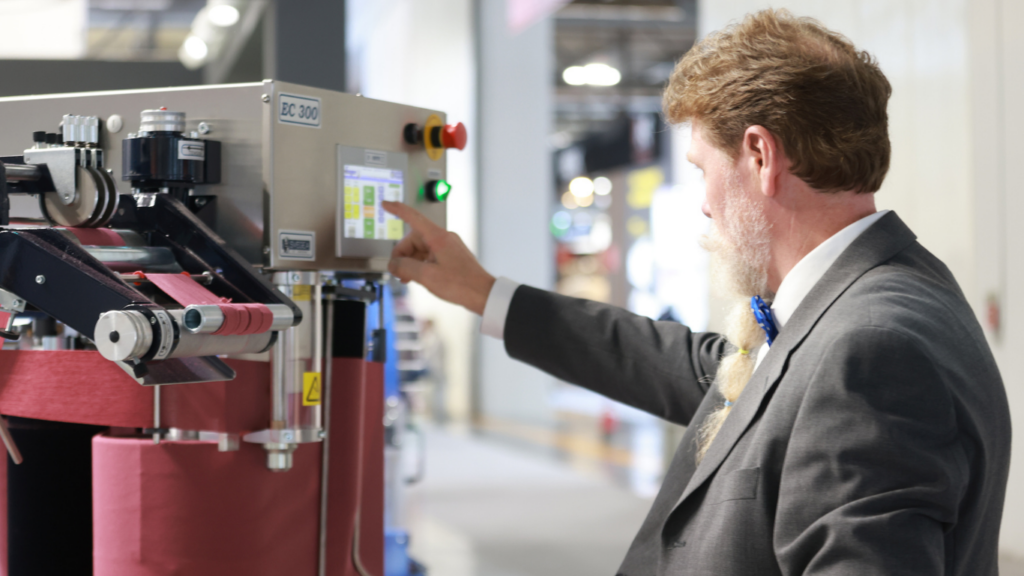
At Svegea of Sweden, flexibility isn’t just a feature—it’s our foundation. Our automated textile production solutions, including Automatic Collarette Cutters, Slitting Machines, and Band Cutting Machines, are engineered for speed, precision, and adaptability.
Here’s how Svegea supports the shift to on-demand production:
- Quick setup times: Ideal for switching between small and large batch runs
- Consistent precision: Every piece meets exact specifications, whether it’s 100 or 10,000 units
- Material versatility: Handles everything from lightweight knits to heavy-duty fabrics
- Just-in-time readiness: Designed for manufacturers who produce exactly what’s needed—no excess, no waste
By enabling manufacturers to meet the demands of today’s fast-paced, customized market, Svegea’s textile solution makes mass customization not only possible but profitable.
📩 Ready to future-proof your factory?
Contact Håkan Steene for a product demo at h.steene@svegea.se or visit https://www.svegea.se to explore our full range of textile solutions.
In modern textile manufacturing, adaptability is no longer optional—it’s essential. As demand grows for flexible production, especially in knitwear and activewear, manufacturers are turning to adaptive garment machinery to streamline operations and maintain quality.
Why Tubular Knit Slitting Matters
Tubular knit fabrics are produced in a continuous loop, which is ideal for circular knitting but not for cutting, printing, or sewing. Before these fabrics can be processed further, they must be slit and opened into flat sheets.
Without proper slitting:
– Edges may distort or curl
– Automated cutting systems can misalign
– Waste increases due to poor edge control
– Finished garments may suffer in quality
This step, though often overlooked, directly affects efficiency and product consistency.
The Role of Adaptive Machinery
Adaptive garment machinery refers to equipment that adjusts dynamically to different fabric types, production speeds, and operational conditions. In tubular knit slitting, this means:
- Automatic edge guiding for alignment
- Adjustable slitting widths for varied outputs
- High-speed operation with minimal waste
- Compatibility with both light and heavy knits
These features allow manufacturers to respond quickly to changing production needs without sacrificing precision.
Integration into Production Lines
Slitting machines are typically placed early in the workflow—after knitting and before cutting or printing. To integrate effectively, they must:
- Fit within existing layouts
- Offer intuitive controls for operators
- Require minimal maintenance
- Support continuous, high-volume use
When adaptive slitting technology is used, production lines become more responsive and less prone to bottlenecks.
Industry Applications
This machinery is especially relevant for:
- On-demand fashion production
- Mass customization models
- Sustainable textile workflows
- Technical and performance apparel
By enabling consistent slitting across diverse knit fabrics, adaptive systems support manufacturers aiming for speed, flexibility, and reduced waste.
A Significant Small Step
Tubular knit slitting may seem like a small step, but its impact is significant. With adaptive garment machinery, manufacturers gain the precision and flexibility needed to meet modern demands.
If you’re exploring ways to improve your knitwear production, consider how adaptive slitting can elevate your workflow.
To learn more or request a consultation, email Håkan at (mailto:hakan@svegea.se) or contact us.
As global demand for ethical and efficient clothing production increases, manufacturers are reevaluating every step of their production process. One area gaining renewed attention is bias cutting—a technique that enhances stretch, durability, and fabric utilization. While often overlooked, bias-cutting systems play a vital role in advancing sustainable garment production.
What Is Bias Cutting and Why Does It Matter?
Bias cutting involves slicing fabric diagonally across its grain, typically at a 45-degree angle. This method allows textiles to stretch naturally, conform to body shapes, and resist fraying. It’s especially useful in garments requiring flexibility, such as:
- Activewear
- Lingerie
- Children’s clothing
- Knit trims and collarettes
By improving fit and performance, bias cutting contributes to the creation of longer-lasting garments—an often underappreciated aspect of sustainability.
Automation and Efficiency in Bias Cutting
Traditionally, bias cutting was done manually. This process was slow, inconsistent, and wasteful. Today, automated bias-cutting systems have transformed the landscape. These machines:
- Align fabric edges with precision.
- Adjust cutting widths for different materials
- Join bias strips seamlessly using integrated sewing units
- Wind fabric under controlled tension for easy handling
As a result, manufacturers can reduce labor costs, minimize waste, and maintain consistent quality across production batches.
Sustainability Beyond the Buzzwords
Sustainability isn’t just about organic cotton or recycled polyester. It’s also about how garments are made. Bias cutting systems support sustainable garment production by:
- Reducing fabric waste through accurate slitting and joining
- Optimizing material usage, especially in high-volume runs
- Lowering energy consumption with efficient, high-speed operation
- Extending product life by improving garment performance
These benefits align with global sustainability goals and industry certifications, making bias-cutting systems a strategic investment—not just a technical upgrade.
Relevance Across Global Markets
From Southeast Asia to Scandinavia, textile manufacturers face similar challenges: rising costs, stricter regulations, and shifting consumer expectations. Bias cutting systems offer scalable solutions for:
- Localized production hubs
- Fast fashion models require agility
- Technical textile producers working with complex fabrics
Whether you’re a small-scale knitwear producer or a large garment exporter, bias cutting technology can support your sustainability roadmap.
Ready to Explore Smarter Solutions?
If you’re looking to enhance your production efficiency while supporting sustainable garment practices, it’s worth exploring what modern bias cutting systems can offer.
Contact Håkan Steene (h.steene@svegea.se) or visit www.svegea.se to learn more about how their bias-cutting solutions align with your sustainability goals.
Small Manufacturers, Global Expectations
In today’s fast-paced apparel industry, small garment manufacturers are under increasing pressure to meet global standards of quality, speed, and sustainability. From trims in Portugal to activewear in North Carolina and knitwear in Vietnam, the demand for scalable textile machinery for garment production is transforming how lean operations compete.
Fortunately, innovation is no longer exclusive to mega-factories. Today’s scalable textile machines are compact, intelligent, and built to empower small manufacturers—allowing them to grow efficiently without compromising craftsmanship. These advanced tools are reshaping how factories adapt, expand, and thrive in a global marketplace.
Success starts with choosing the right machinery—and scaling smart from the start.
The Power of Precision in a Compact Package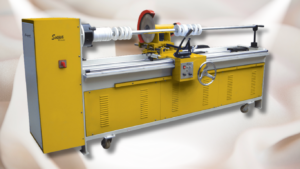
Gone are the days when automation was reserved for mega-factories. Today’s machines are modular, compact, and built to integrate seamlessly into lean production environments. They offer:
- High-speed performance without overwhelming your floor space
- Energy-efficient motors that reduce operational costs
- User-friendly interfaces that minimize training time
- Consistent output that supports quality control
Take the Svegea CMS 1800A2 Strip Cutter, for example. It’s engineered for high-speed strip cutting from tubular or open-width fabric—ideal for bias tape, trims, and bindings. Its compact footprint and low-maintenance design make it a smart fit for small operations looking to scale without stress.
Why Scalability Beats Size
Scalability isn’t about becoming a giant—it’s about being ready. With scalable machinery, you can:
- Respond quickly to seasonal surges
- Take on new contracts with confidence
- Maintain consistent quality across product lines
- Reduce reliance on manual labor during peak periods
This flexibility is especially critical in regions where labor costs are rising or skilled operators are in short supply. Machines like the CMS 1800A2 help bridge that gap, offering reliability without complexity.
Sustainability: A Strategic Advantage
Eco-conscious production is no longer a niche—it’s a requirement. Buyers across Europe and North America are demanding transparency, traceability, and reduced environmental impact. Textile machinery plays a pivotal role in meeting these expectations.
Modern machines consume less energy, produce less waste, and support cleaner workflows. For manufacturers aiming to align with ESG goals or attract sustainability-focused clients, upgrading equipment is a strategic move—not just a technical one.
Empowering Craft, Not Replacing It
Small manufacturers often pride themselves on craftsmanship. That shouldn’t change. But smart machines can support that craft by handling repetitive tasks, freeing up skilled workers to focus on design, finishing, and quality assurance.
It’s not about replacing people—it’s about enabling them to do their best work.
Transitioning Without Turbulence
Worried about disruption? Designers create today’s textile machines for smooth integration. With proper planning, upgrades can be implemented with minimal downtime. Scalable textile machinery systems for garment production offer multilingual interfaces and remote support, making onboarding faster and easier.
The CMS 1800A2, for instance, has an intuitive setup and reliable performance—making it a low-risk, high-reward investment.
Final Stitch: Invest in What Moves You Forward
The garment industry is evolving. Markets are more demanding, timelines are tighter, and sustainability is non-negotiable. For small and mid-sized producers, the path forward isn’t paved with massive capital—it’s built on smart, scalable decisions.
Modern textile machinery offers a way to grow without losing control. It’s not about chasing volume—it’s about building resilience.
Ready to explore how one machine could reshape your production flow? Contact Håkan Steene (h.steene@svegea.se) for a product demo or more details. No pressure—just possibilities.
- 1
- 2

